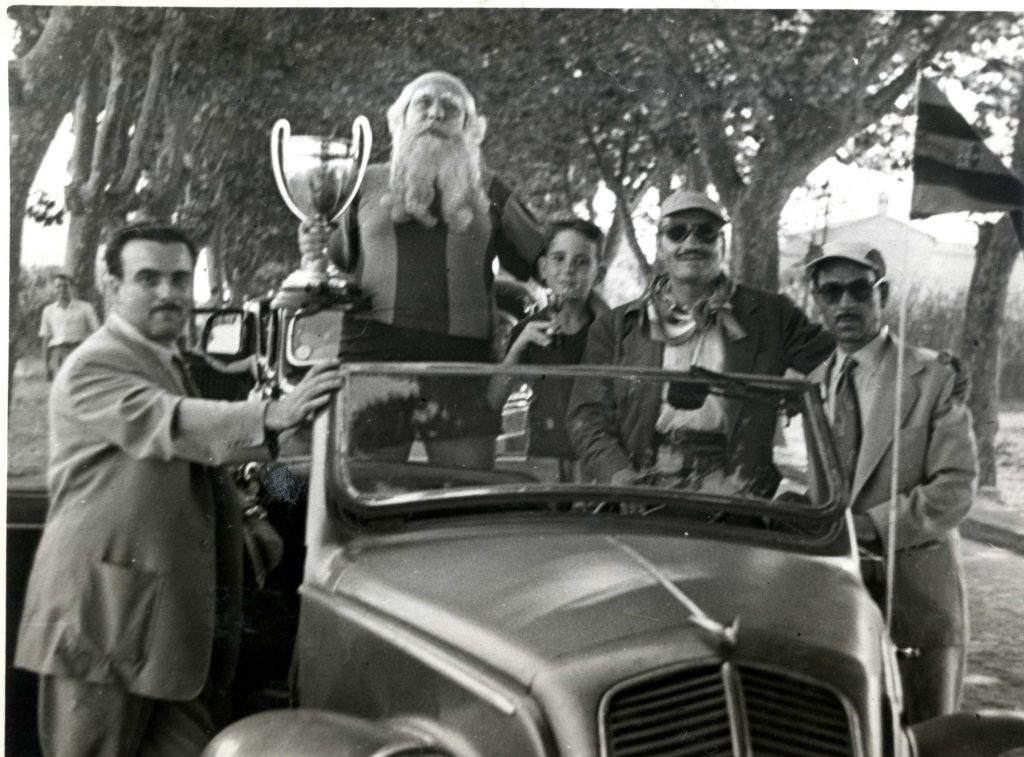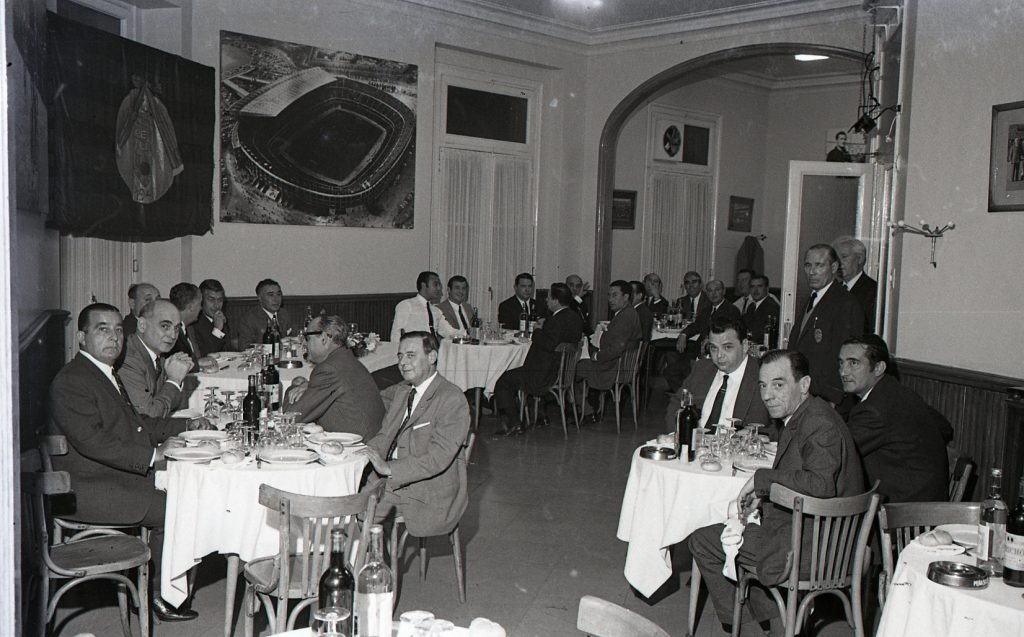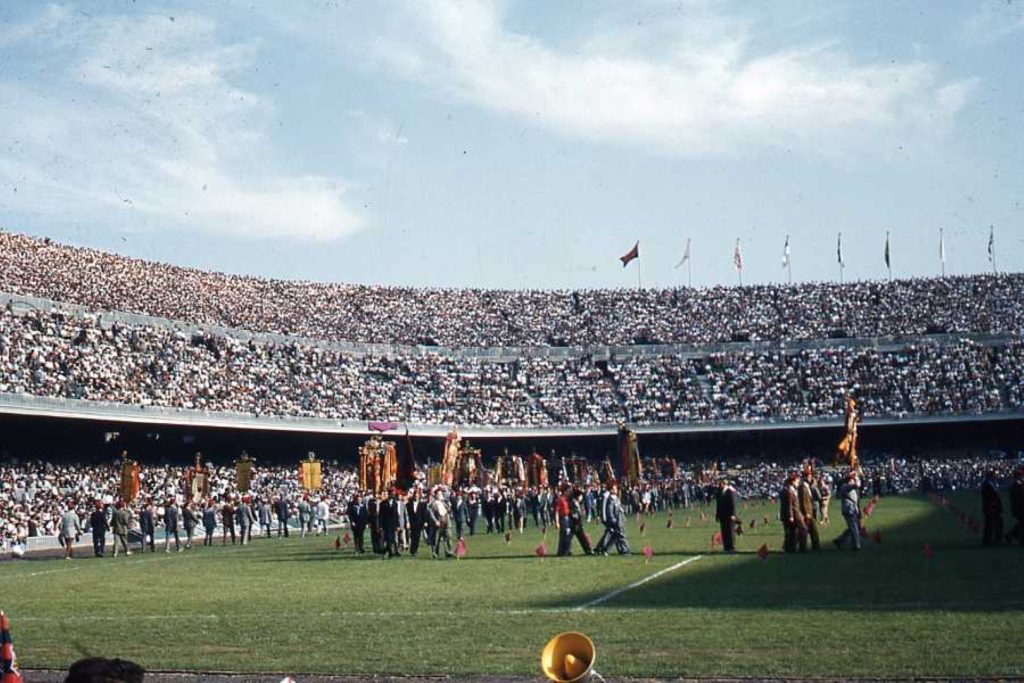The penya Solera was created in 1944, coinciding with Josep Samitier’s return to FC Barcelona, this time as coach, and prior to the blaugrana team’s second league title. It was the first penya founded after the war, thanks to the auspices of Samitier himself and Jaume Ramón. We can even say that it could be considered a strategic maneuver of the founders of the penya, with “Sami” at the head, to reactivate a movement that they considered necessary to encourage a fan base that needed a boost in that hard post-war period.
The 20s had already been a pleasant experience with the proliferation of penyes that brought the idols closer to the fans. In the publication Barcelofília: inventario de la Barcelona desaparecida, we can find:
Considered a key association in the history of the penya movement linked to FC Barcelona, the Peña Solera was born in 1944 in a rather difficult environment. The pre-war blaugrana penyes had disappeared and a small group of culers, including Josep Samitier, Evarist Murtra and Jaume Ramon, met at the Solera bar on the Rambla, very close to the Canaletas fountain. They were the ones who decided to start the Penya Solera. The first activities of the new penya focused on the organization of trips to follow the team on its travels. Over the years, well-known players of the club such as Mariano Martín, César Rodríguez, Antoni Ramallets or Gustau Biosca were added, until later a man who would end up being key in the history of the penya joined. We are referring to Nicolau Casaus, who would be the president during several stages.
The social premises of the penya changed location over the years: during the early days, it was installed in the same social headquarters of FC Barcelona, in the chalet in the Méndez Vigo passage. Later, they moved to Trafalgar 4, near Plaza Urquinaona; then, in 1954, they moved to Pelai 40, and finally, in July 1976, to Avenir Street between Amigó and Santaló. The Penya Solera was the promoter and catalyst for other Barça penyes all over Catalonia and many of them adopted the name Solera before the name of the town where they were based. In 1952, its official name was changed to Peña Barcelonista Solera. Its activity was intensifying with the organization of numerous social and sporting events, so it ended up becoming a kind of factual power within the club.


The entry of Nicolau Casaus
From 1947, Nicolau Casaus would become the soul of a penya that was a meeting point for all kinds of characters from the blaugrana world, as well as the scene of unusual revelries shared in total harmony between players and some members. It was also an ideal and discreet place for love games between football players and celebrities. In its origins, like most penyes, it was a recreational association made up of fans, members and footballers, sometimes from different clubs. Nicolau Casaus joined before becoming a member of FC Barcelona, on February 10, 1948. Four months after joining the penya, and after having been vice-president, he was named president. Since then, the name of this penya has been completely linked to the figure of Nicolau Casaus de la Fuente Jené.
As president of the Penya Solera, he was very critical of the presidencies of Agustí Montalt y Galobart and Enric Martí Carretó. In some cases, he even signified himself as a possible parallel power that, in some way, the directives would have to silence. In the 1953 election, Nicolau Casaus, then president of the Penya Solera, supported Francesc Miró-Sans. This was the first time that Barça members had been able to choose their president since the end of the Civil War, since until then the presidents of football clubs were appointed directly by the Franco regime. At that time, only men were allowed to vote, and a total of 17,241 voted. The winner was Francesc Miró-Sans by a margin of 301 votes. It was an election in which members voted by cards and not by persons, so a member could vote as many times as he/she had membership cards.
A very influential figure
In 1957, perhaps due to the power he was gaining with his penya, Casaus was appointed president of the Organizing Committee of the Social Events of the Inauguration of the Camp Nou. In relation to these acts, in Montserrat, Casaus was one of the privileged ones who made a very moving speech, as was his custom, but later he was not invited to the table of authorities at the gala meal. Some say it was because of Casaus’ own preference to sit with “his people”, but other sources say it was because of his criminal record; and a third version says that he was simply excluded because he was not a member of the FC Barcelona Board of Directors. For this or other reasons, Nicolau Casaus left the presidency of the Penya Solera in 1957 to return to the post in 1959.
Going back to 1954, Casaus was one of those who moved the foundation stone of the Camp Nou, which was the same as that of the Camp de Les Corts. An expulsion order was also issued against him for having taken down a portrait of Franco, but the intervention of Josep Samitier and Jose Maria de Cossío prevented it; however, he had to temporarily step down as president of the penya. Another version of this fact is that in the landing of the staircase of the local of the Penya Solera there was the portrait of Franco that one day Casaus took down and left on the floor. Considering his past and his time in prison, it was not a good idea, since, perhaps alerted by the many “informers” that the Regime had infiltrated everywhere, the police appeared asking why the portrait was on the floor. Casaus calmly replied: “It must have fallen. A gust of wind. See, the glass is broken.”
It is hard to be certain about all the anecdotes or stories about Nicolau Casaus. In any case, whether they are true, exaggerated or simply urban legends, they are worthy of being written about and remembered.







